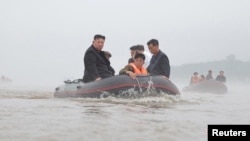North Korea continues to keep its doors shut to international aid workers as the country struggles with massive flooding that destroyed thousands of homes and covered vast farmlands.
The International Federation of Red Cross told VOA on Thursday that it was assessing North Korea’s humanitarian situation and needs from the floods as it remained hopeful about reentering the country.
“We are deeply concerned about the impact of the floods and are working closely with the DPRK Red Cross Society to assess the situation,” the IFRC said in a statement to VOA Korean.
“With the recent opening of DPRK borders and increased international cooperation, we are hopeful about the reestablishment of IFRC’s international presence in DPRK,” the statement continued.
The Democratic People’s Republic of Korea is North Korea’s official name.
The U.N. resident coordinator in North Korea, Joe Colombano, told VOA on Thursday that "we stand ready to return to the country to support" North Korea as it recovers from flood damage, "as well as with longer-term resilience work, should the government so request." He also extended condolences to those impacted by the floods in a written statement from the U.N. Development Coordination Office in New York.
North Korea reopened its borders in August 2023 and lifted draconian pandemic measures put in place since 2020 that blocked all cross-border activities, including humanitarian aid.
No international aid workers are in the country despite the open border, although there was a four-day visit to Pyongyang by the head of the Food and Agricultural Organization in July.
The U.S. State Department told VOA Korean on Thursday that it hoped North Korea “will soon allow international humanitarian workers back into the country” as it stood ready to support international aid efforts.
“We continue to support international efforts to provide critical humanitarian aid to the DPRK,” a State Department spokesperson said.
The U.S. provided $1 million in humanitarian aid to North Korea in 2017 after the country was hit by Typhoon Lionrock the previous year, resulting in flooding. But the U.S. does not currently provide any aid to North Korea.
After being pummeled by heavy rains since last week, North Korea has mobilized officials and residents of several provinces to send relief items such as tents, blankets, garments and medical supplies to the flood-hit areas of North Pyongan and Jagang provinces, according to state-run KCNA on Thursday.
North Korean leader Kim Jong Un held an emergency meeting after inspecting flood-hit areas in North Pyongan province, where the rains flooded more than 4,100 houses and nearly 3,000 hectares of farmland in Sinuiju city and Uiju county that borders China, KCNA said Wednesday.
More than 4,300 people were rescued by North Korean army helicopters from the flood-hit regions, according to KCNA on Monday. But North Korea did not provide an estimated number of deaths or injured from the devastating flood.
North Korea is prone to flooding from summer downpours because the country lacks proper infrastructure to support drainage.
VOA contacted North Korea’s mission at the U.N. and asked whether the country was willing to accept international aid toward flood recovery but did not receive an answer by the time this report was published.
The South Korean Unification Ministry that handles inter-Korean affairs said Thursday that North Korea seemed to have incurred considerable casualties. Some South Korean media reported the number of flood victims, including deaths and those displaced, to be more than 1,500.
Jerome Sauvage, who served as the U.N. resident coordinator in North Korea from 2009 to 2013, said the impact of the flood, including an estimated number of deaths, is difficult to assess “from a distance” and should be done from inside the country.
“Without data obtained on the ground and independently,” it is also difficult to assess how much aid is needed, Sauvage said. He suggested North Korea “urgently” let in a staff for an assessment on the impact of the floods, including damage done to crops, houses and facilities.
South Korea’s Red Cross said in a statement released through the Unification Ministry on Thursday that it was willing to provide relief aid to North Korean flood victims.
The Korean Red Cross said it was “ready to discuss details including relief items, amount of aid supplies and delivery methods” with the DPRK Red Cross Society as it looked forward to a “prompt response” from North Korea.
It was uncertain whether Pyongyang would accept help from Seoul amid tense relations between the two.
Keith Luse, executive director at the National Committee on North Korea in Washington, who facilitates engagement between the U.S. and North Korea, said, “If DPRK officials decide to accept assistance from other countries, China and Russia will likely be the initial points of contact.”
Liu Pengyu, a spokesperson for the Chinese Embassy in Washington, told VOA that “China is paying close attention to the flooding and expresses heartfelt sympathies to the bereaved families and those who are affected.”
“We believe that the people of the DPRK are capable of overcoming the impact of the disaster and rebuilding their homes soon,” he said.
Liu added, “In the meanwhile, areas on the Chinese side near the border have also been hit by severe flooding. We hope the two sides will share flooding information in a timely way to better prevent the flooding and ensure the safety of people’s life and property.”
VOA contacted the Russian embassies in Washington and Seoul to ask whether Moscow had a plan to send disaster relief aid to North Korea but did not receive a reply.
Eunjung Cho contributed to this report.









